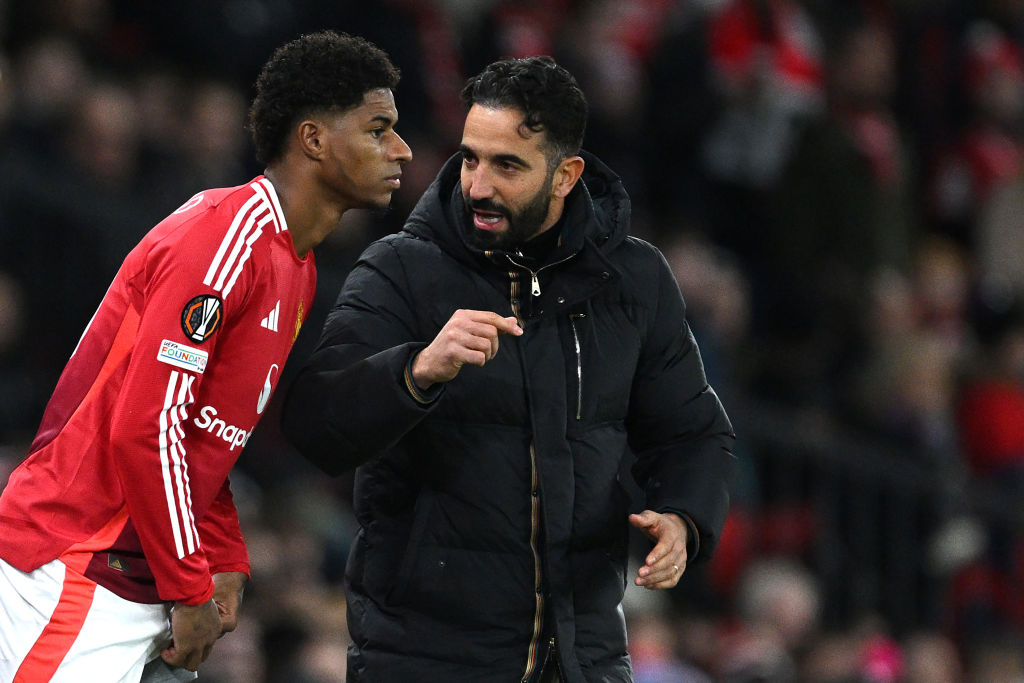How did Barcelona's academy lead to a club in crisis? The inside story of the death of La Masia
Barcelona had the most celebrated youth system in the world – designed by Johan Cruyff, and bringing through the likes of Messi, Xavi and Iniesta. Now, after years of big spending, they're in trouble
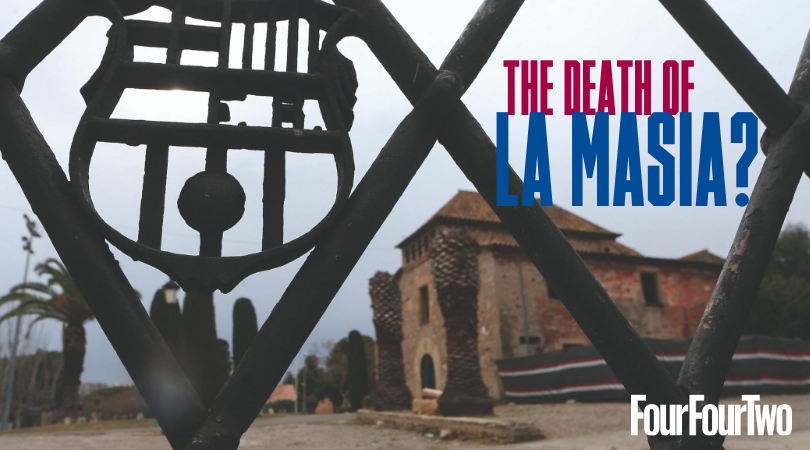
This feature first appeared in the June 2020 issue of FourFourTwo magazine. Subscribe now and get your first five issues for just £5
In December 2012, FourFourTwo met Victor Valdes for the very first time at Barcelona’s new training ground. A month earlier, the Catalan Masia graduate had featured in an away game at Levante when, in another first, the 11 players on the pitch were products of Barça’s fabled academy. The goalkeeper was understandably extremely proud.
“You can’t ask for any more than 11 players who have come through the youth system,” he beamed. “It’s something all the other great teams in the world should aim for. Why not? You don’t have to make big signings to have a great club.
“This is the result of work that had been done 15 to 20 years before – it didn’t happen overnight. The people they owe this to are not at the club now. I received a lot of messages from old coaches after the game. They were part of the success, too.”
The roll call was formidable: Valdes, Montoya, Pique, Puyol, Alba, Busquets, Xavi, Fabregas, Pedro, Iniesta and Messi – and they eased to a 4-0 victory at the Estadi Ciutat de Valencia.
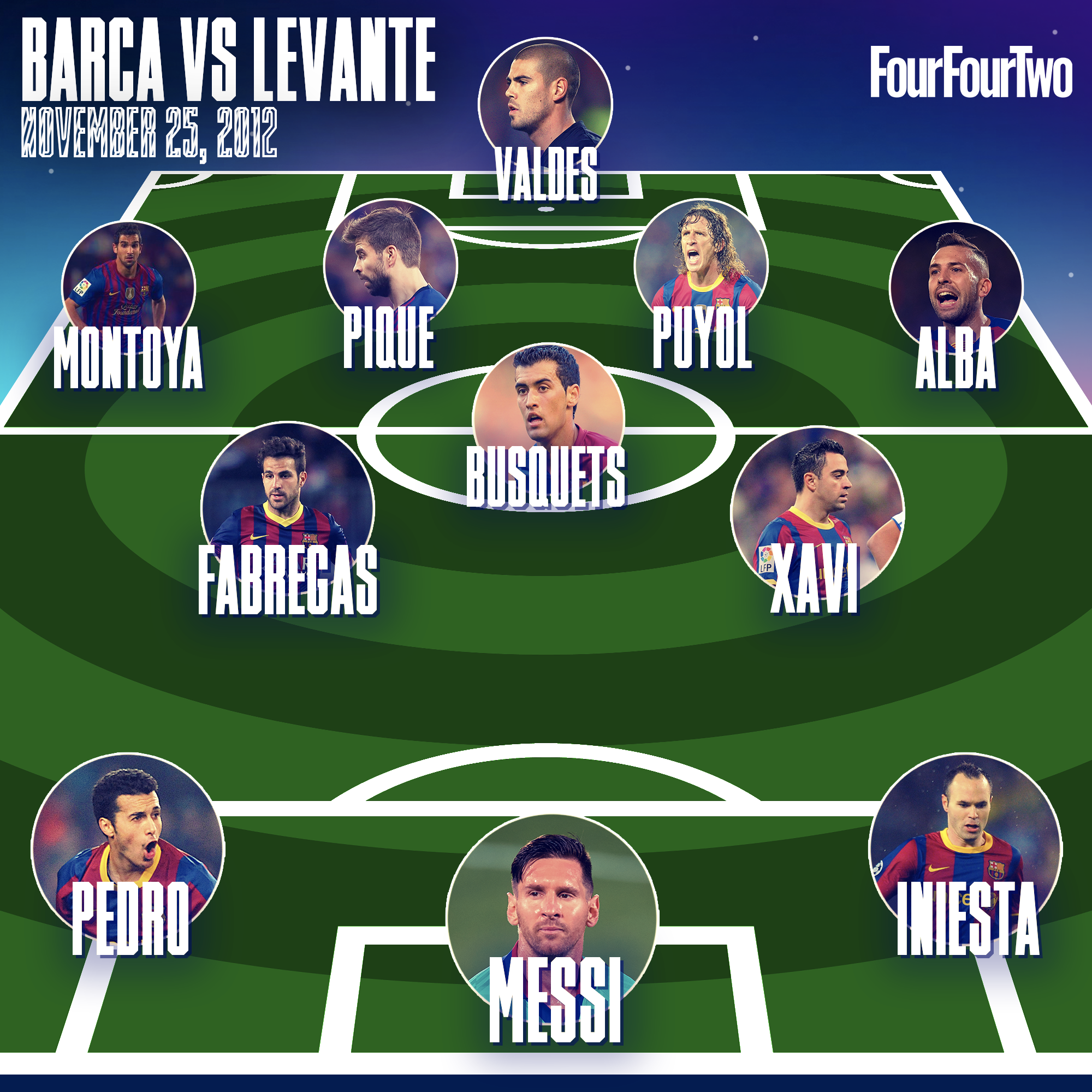
More graduates from La Masia were on the bench. The coach was Tito Vilanova, himself a former Masia student who became the No.2 to Pep Guardiola’s first managerial successes. The Catalans’ training complex is now named after Vilanova, who died from cancer in 2014.
The training ground, situated five miles from the Camp Nou in the Llobregat river valley, is better equipped than the true Masia: a former farmhouse (the literal translation of ‘Masia’ in Catalan) which still stands outside Barcelona’s famous stadium. As recently as 2007, tourists on buses could see Barça’s first team training right outside the ground.
Get FourFourTwo Newsletter
The best features, fun and footballing quizzes, straight to your inbox every week.
The conditions were cramped, and Barcelona were one of several clubs to upgrade to more modern, spacious facilities. Their new training ground isn’t as grand as Real Madrid’s, but still houses 84 prospects in a building which looks like an Ibis hotel. Rather than pictures of fruit or lush forests on its walls, however, it features many of the former graduates who have made it into the first team.
BARÇA FIRESALE Which Barcelona players could leave the crisis club this summer?
In reception, there is a massive group shot of Lionel Messi, Andres Iniesta and Xavi, the triumvirate who headed the 2010 Ballon d’Or voting. When they leave their rooms, starlets see a sign proclaiming: ‘Together we’re strong’. There are also images of both Johan Cruyff and Laureano Ruiz: heavily influential in the club’s youth revolution of the 1970s and ’80s, and an inspiration to the Dutchman.
Barça want to produce upstanding people as well as great players. Education is important: respect is taught, with opponents never called enemies. Talk is of creating, not destroying; of recovering the ball, not stealing it. The Wi-Fi is switched off at night.
The players have an attractive view of their new €12 million, 6,000-capacity Estadi Johan Cruyff which opened in 2019. It’s 10,000 seats smaller than the mini Estadi it replaced by the Camp Nou, but 6,000 is a more realistic figure for Barça’s B team, who have averaged around 2,900 fans over the last decade. A new ground means the days when supporters could watch the B team and then skip across to the Camp Nou for a first-team match are gone. Barça’s women, one of the best teams in Europe and Champions League finalists in 2019, also use the stadium and get similar crowds.
Pictures and quotes of Cruyff are all around to inspire younger players, including, “Football is a game you play with your brain” or “I prefer to win 5-4 than 1-0”.
It’s a home fit for La Masia’s reputation as the world’s best academy, but that reputation is not what it was. With good reason.
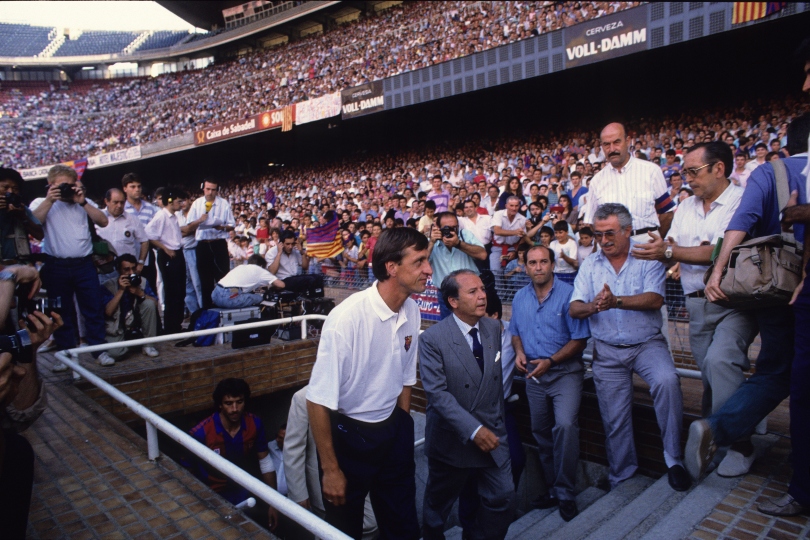
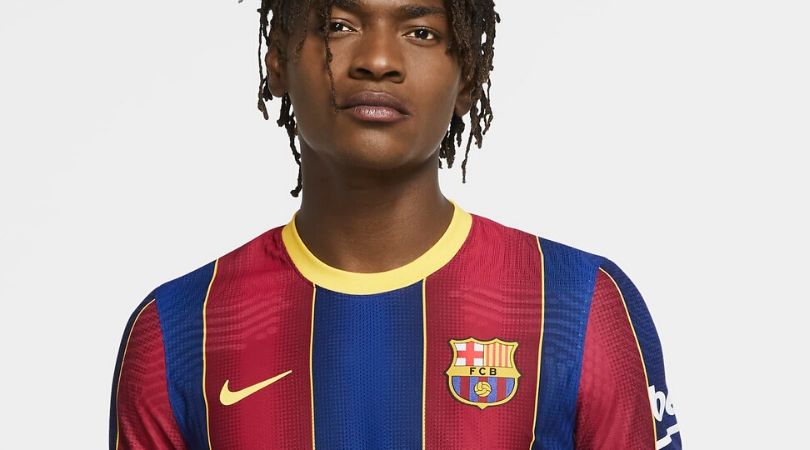
NEW SHIRT Barcelona return to tradition with eye-catching 2020/21 home kit
Levante in 2012 was the high point for Barça’s cantera, La Masia’s quarry. The first team, who had won only one league title between 1974 and 1991, had metamorphosed into regular La Liga and Champions League winners, with a mainstay of local players supplemented by international heavyweights drawn to a superb team, club and city. Ferran Soriano, now the chief executive officer at Manchester City and for five years the vice-president of Barcelona, preached that it was a virtuous circle where success fed success.
“In 2010, the stars aligned and three Masia players were the best in the world according to FIFA,” says Jaume Llopis, an ex-footballer, close friend of Cruyff and prominent Spanish economist who’s part of the Former Barcelona Players group. “This will never happen again in the history of football. La Masia was then the base of the first team, with eight graduates in each game. And of course, there was also the 11 against Levante.”
So why won’t it ever be the same again, and what have the Catalans done wrong en route?
“Barça lost the original meaning of La Masia,” a Catalan youth coach who’s worked at Barça and Espanyol tells FFT under anonymity.
“The original theory came from Johan Cruyff, Rinus Michels, Laureano Ruiz and people like Josep Lluis Nunez, the former club president. Then Louis van Gaal and Pep Guardiola followed and took care of La Masia.
“They got the best players in Catalonia, Spain and, later, the likes of Messi from Argentina. It was also cost-effective and made sense – the players were prepared to play the same way as the first team and got their chance.”
Jordi Quixano, who covers Barça home and away for daily newspaper El Pais, puts it down to the club getting distracted by the question of independence, while also spending a great deal of money on redeveloping the crumbling Camp Nou. The result was, believes Quixano, that “Barcelona lost the model because those in charge didn’t share the long-term vision of their predecessors.”
NEWS Quique Setien sacked by Barcelona after Bayern Munich thrashing
So how have the club responded? Quixano is quick to point out in their defence that Barça insist La Masia is now a priority, and there have been some improvements.
“They do intend to return to that philosophy, but I doubt it can get back to where it was,” he explains. “Too many things have changed; too many players now take the big money on offer from the English Premier League, which Barça won’t pay to young players. The recession will likely cut deep at Barcelona.”
The Catalans have the highest wage bill in the world, which made up 70 per cent of their entire turnover in 2018. They needed to cut it. Huge signings like Antoine Griezmann, Philippe Coutinho and Ousmane Dembele – the game’s fourth-, fifth- and sixth-most expensive players of all time – have, for various reasons, failed to replicate their previous form. Messi’s salary is so colossal that it adds additional imbalance. President Josep Maria Bartomeu quipped to one equivalent that his entire job was bringing in enough money to pay Messi’s wages.
The Argentine is arguably the greatest-ever footballer and progressed through Barcelona’s youth system, but even he admits it isn’t the conveyor belt of brilliance it once was. In 2018 he said, “We have lost a bit of our commitment to the academy. Important youngsters have left, and it is rare that this happens at the best club in the world.”
Manolo Marquez, a Catalan who succeeded Quique Setien at Las Palmas in 2017, thinks the club’s fans should share some of the blame.
APROPOS OF NOTHING, ALSO READ The worst Barcelona managers of all time
“Barcelona is not Chelsea,” he tells FFT. “Too many fans admit they like the idea but won’t accept trying younger players, rebuilding and finishing 4th. It’s 1st or 1st.
“Ernesto Valverde knew this and was more hesitant to try the youngsters. Setien, a friend who I have so much respect for, has beautiful football ideas – but he needs to win La Liga or the Champions League.”
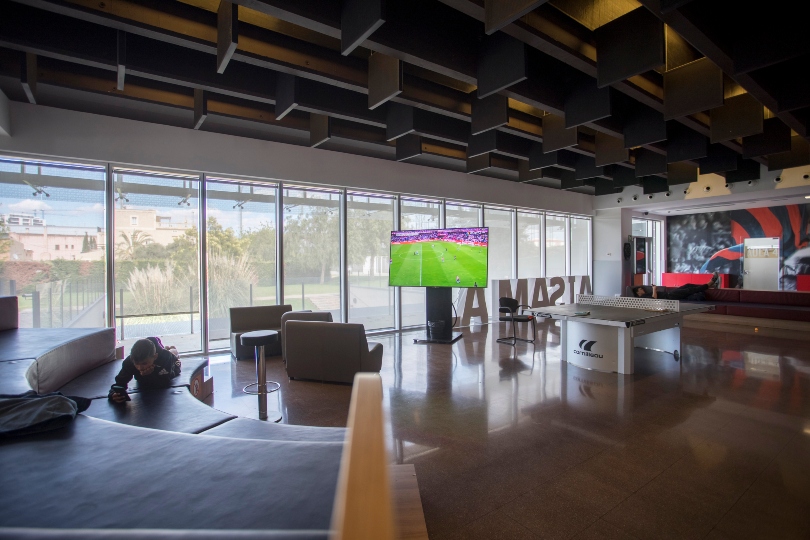
Setien’s last Barça game before Spain entered coronavirus lockdown, a 1-0 victory at home to Real Sociedad, began with four graduates from La Masia: Messi, Gerard Pique, Sergio Busquets and Jordi Alba. All are over 30.
Was the bench brimming with talent ready to take over? Not really. Just three of the seven substitutes came from Barcelona’s academy: Riqui Puig, Alex Collado and 17-year-old Ansu Fati, this season’s breakthrough star and the one looking most likely to be a genuine Masia success. Eleven of the matchday 18, therefore, were brought in from the outside.
Barça’s B team have been playing in Spain’s third tier since 2018, which is a decline from past glories. However, Marquez believes they now have a good coach in former winger Xavi Garcia Pimienta (left), who’s being hampered by current policy.
“He has been there a long time and helped many great players come though the ranks,” reveals Marquez. “He coached Barça’s UEFA Youth League-winning team in 2018. I could see him in charge of the first team one day, but for now he’s in the regional third division and the players are 20 or 21 when they used to be 23 or 24. Most of the best young players have been sold.”
Spain’s localised Segunda Division B is made up of 80 clubs and has average gates of 1,000. The gulf between that and the senior team is huge. Barça B spent most of the last 10 years in the second tier, at a far higher level.
Former Barça B captain Arnau Riera believes the gulf is too great.
“The intensity is higher in the first team,” he tells FFT. “When I moved up to train with them, I was surprised by how fast it was. I played in a good B team: Messi, Valdes, Iniesta, Oleguer Thiago Motta and Fernando Navarro made the first team. We had all hoped to do that, but we also knew the odds were against us. It’s very hard to make the jump and establish yourself in the senior side, play twice a week and deal with the mental pressure of criticism if you’re not playing at your best. Sometimes, it’s better if you don’t have the intelligence to notice and just focus on your football.”
But the philosophy was the same throughout Barça’s teams.
“Pass and move,” continues Riera, who later featured for Sunderland, Southend and Falkirk. “Recover the ball quickly. Get possession. Fast transitions. We were told that if you have the ball, you’ll have more chances to get closer to the goal. There were few 11 vs 11s in training – it was more small-sided games; two touch. You’re good if you play for Barcelona, and there is a self-assured arrogance that ‘we wear this shirt, we are the best’. But the progression has stalled compared to when I was there, and the style has changed, too. The B team play more physical football in the third division.”
So how has it come to this? Friend of Cruyff, Llopis, points the finger at those looking after grassroots football under ex-president Sandro Rosell and current incumbent Bartomeu.
“They depleted and razed La Masia’s ideals,” he claims. “They signed 47 players for Barça B and not one made it into the first team – they mortally wounded La Masia.”
Rosell’s hands were tied and the Catalan was partly complicit: he had been in charge when Barça broke FIFA rules between 2009 and 2013 by recruiting 10 international players under the age of 18. The club were sanctioned and given a 14-month transfer ban.
“That did a lot of damage,” concedes Llopis. “No new players arrived and some of the most promising ones left.”
One such starlet was South Korean attacker Lee Seung-woo, the so-called ‘Korean Messi’. He’s now 22 and made four league outings for Belgian side Sint-Truiden in 2019/20. Barcelona sold him to Serie A side Verona for just €1.5m in 2017 and inserted a buy-back clause. Then there are the players who left the first team for big money: Pedro for €30m, Thiago Alcantara for €25m and Gerard Deulofeu for €13m. They were given time to establish themselves.
Not every world-beater at 15 goes on to be the next Messi, but do the young Barça players get a fair chance in 2020? Another Cruyffista, the Catalan Carles Guardia – also a companion of the Dutch legend – thinks not.
“La Masia is a business now,” he says. “If we can learn from the pandemic, it’s that La Masia is necessary because players can’t be signed at the current rates. But this board didn’t believe in it. Too many players were sold and there was too little perseverance with some of the others. Barcelona cashed in.”
🔴🔵 Barcelona 2-8 Bayern Munich ⚪️🔴Things got a little out of hand in Lisbon... A statement made by Bayern, crisis time for Barca, somehow we've squeezed it all into 60 seconds 👇#Club2020 pic.twitter.com/Ndi85cuVLVAugust 14, 2020
Barça are not the only ones: Manchester City operate on similar lines.
The Premier League giants bring youngsters to the club hoping some will play for the first team, but the odds are stacked against them and what chance do they have if Jadon Sancho leaves in search of regular football? City cash in, selling guys like Manu Garcia, Douglas Luiz and Aaron Mooy for millions apiece. The theory is that their youth system is profitable.
“It’s the Ajax model,” says a current La Liga sporting director, in the market for emerging Barça players who won’t make the first team. “It’s business, and the Masia name was perfect from a marketing perspective. The name is an inspiration for young people around the world, but clubs and agents pick off the players now.”
Having Barcelona on your CV certainly helps, as it instantly draws interest from the outside. Barça were stung when Cesc Fabregas chose Arsenal and Gerard Pique left for Manchester United as kids – a trend which hasn’t stopped.
“There are vulture-like agents who have done a lot of harm, taking children on contracts via their parents with the promise of making huge amounts of money,” laments Llopis.
Far better to get a Messi at 14 than try to buy him at 24, as Barça are doing more and more.
“The best generation was the class of ’87,” adds Llopis. “Plancheria, Valiente, Pique, Cesc, Songo’o, Clausi, Riera, Giribet, Vazquez, Messi. The one from ’91 wasn’t too bad, either: Thiago Alcantara, Montoya, Bartra, Rochina, Pacheco, Tello. They had some really good players then, but less so today. FIFA regulations damaged Barça; the high salaries offered by other clubs, too. And they also need first-team managers like Pep, who give kids a chance.
“Barcelona invest a lot in La Masia, but they don’t want to pay big transfer fees for kids and that’s key. They think there’s a better way.”
But is there? The big clubs are swooping for each other’s youngest stars. Juventus signed Paul Pogba from Manchester United and also wanted Mason Greenwood, offering his family life-changing sums of money in 2019. United, after letting their youth system slip during the post-Alex Ferguson era by failing to keep pace with the cash that Chelsea and Manchester City were sinking in, now spend five times as much on their youth setup as they did five years ago. The Red Devils don’t release overall figures, but in July 2019 they splashed £9.3m on Hannibal Mejbri, a 16-year-old from Monaco… who had paid £1m for him when he was 14.
Barça would not pay these kind of fees under president Bartomeu and ex-general manager Pep Segura. Recently they have lost a string of Spanish youth internationals, including Adrian Bernabe (18) to Manchester City, Sergio Gomez (19) to Borussia Dortmund, Pablo Moreno (17) to Juventus, Jordi Mboula (21) to Monaco, Abel Ruiz (20) to Braga, Carles Perez (22) to Roma, and Robert Navarro (17) to Monaco and then Real Sociedad. The most hurtful exit was surely that of defender Eric Garcia to City in 2017, if only for the fact that his agent was none other than Barça royalty Carles Puyol. Almost all of these players are Catalan. They were 16 years old and on €15,000 per year as part of a first contract. City, for example, can offer €250,000.
Barça may be well off, but they are owned by their members and simply can’t compete with the sovereign wealth fund of a whole country.
“Some players are still coming through, but not many,” says Quixano of El Pais. “Ansu Fati is the most notable from the last few seasons. Carles Perez didn’t get enough games; nor did Carles Alena and he was loaned to Real Betis. [Former manager] Ernesto Valverde went with more experienced players.”
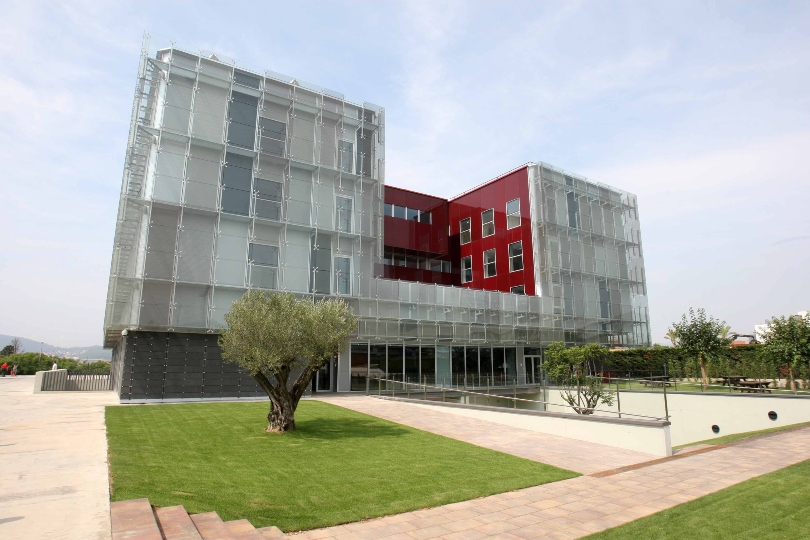
Hindsight does not judge some of Barcelona’s decisions well. Left-back Marc Cucurella was one the best players on show at the Camp Nou this season – but the Catalan was playing for fourth-placed Getafe, having been allowed to leave for €6m in 2019 (Barça are also entitled to a 40 per cent sell-on fee). Was Dominican Junior Firpo, signed for €18m from Betis with €12m in add-ons, really a step up? He hasn’t been a regular, but another example of Barça’s transfer profligacy which means they need to sell players to raise money.
Forward Ruiz joined Braga on loan in January, but the Portuguese side can keep him for €8m. Barça’s buy-back clause is €40m if they want him within two years.
Winger Perez – who featured in six of Barça’s opening seven league games of 2019/20 and scored in a 5-2 win against Betis – was loaned to Roma with an obligation that the Serie A side pay €11m to sign him permanently. After netting a Europa League winner against Gent, he sighed, “I don’t know what happened [at Barça]. They didn’t give me a good explanation, and said 10 days before the transfer window closed that I was leaving. They no longer have patience with youth – it hurts. My dream was to play and it was taken away. They talk a lot about La Masia, but do the opposite.”
Barça run close to the wind financially – as became apparent when temporary wage cuts were enforced a fortnight after La Liga stopped due to the coronavirus pandemic. Ultimately, the sums they are selling their youngsters for are difficult to turn down.
The club’s youth coaches are relatively well paid these days, earning €45,000 per year and upwards from age groups 12-19. Their scouts are less so: €8,000 per year to watch players all over Spain at weekends. Older youth coaches cashed their cachet in and accepted jobs in the Gulf, China and Japan, charged with bringing the Barça model to whichever side they joined.
There is also the business of Barça’s football schools. Like many of the elite clubs, they run 50 academies worldwide where young players spend $3,000 per year to train the Barcelona way. Yet some of their greatest names never paid a penny on their rise to the very top. Only Sergi Samper, a middle-class Catalan treated to a soccer school course by his grandfather, was immediately picked out and put into the traditional schools where the players don’t pay.
Barça are due presidential elections in 2021. For some, this is too long a wait.
“The new president must make his very first objective to revitalise La Masia and make it an example for the world again,” advises Llopis. “With the coronavirus and economic crisis at Barça, the only way out and a future strategy lies in all the good things that still exist in the Barcelona DNA and methodology.
“A lot has been lost. A year ago, it was led by [director of methodology] Joan Vila, who had brought through so many players across four decades. Now he’s gone, too [after his contract wasn’t renewed in the summer of 2018]. It’s time for a ‘foc nou’ with La Masia.”
That’s a ‘new start’ in Catalan. Once Spain eventually returns to normal, there will also be a strong desire to restore Barcelona’s values – not just their famed youth academy – back to former glories. As the legendary Cruyff once reflected: “There is no greater medal than to be acclaimed for your style.”
While you’re here, why not subscribe to the mag - get your first five issues for just £5, almost £25 cheaper than buying it in the shops!
NOW READ...
CLASSICS 6 brilliant European Cup matches you’ve probably never heard of

Andy Mitten is Editor at Large of FourFourTwo, interviewing the likes of Lionel Messi, Eric Cantona, Sir Alex Ferguson and Diego Maradona for the magazine. He also founded and is editor of United We Stand, the Manchester United fanzine, and contributes to a number of publications, including GQ, the BBC and The Athletic.
